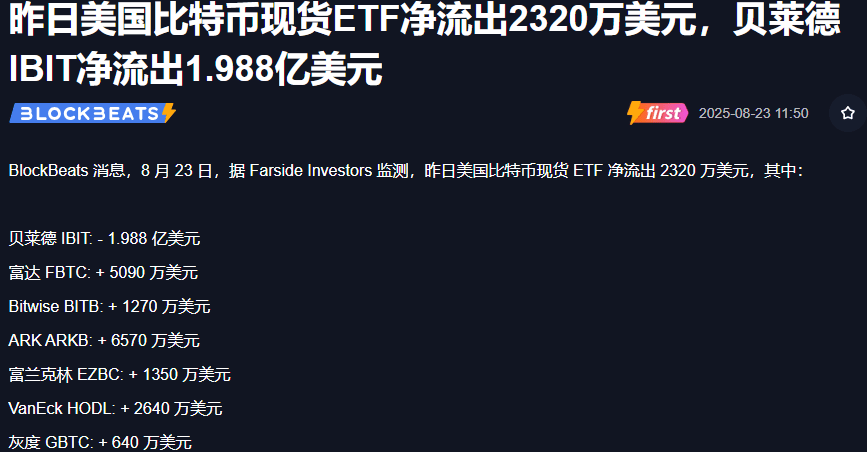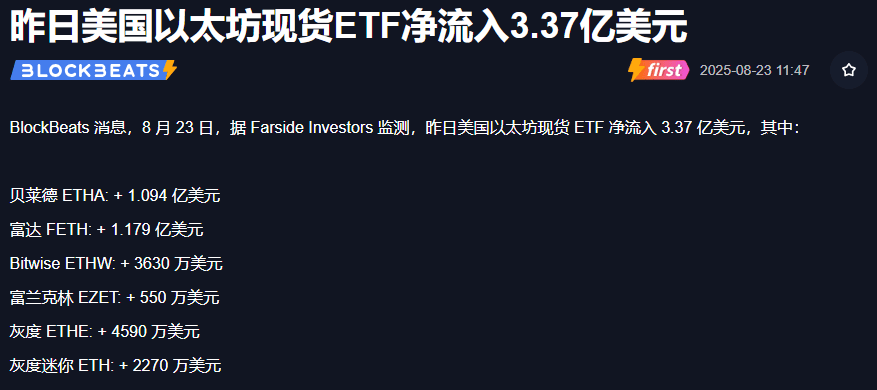'The wheel of fortune turns, and the crypto circle goes crazy': How did Bitcoin get 'overshadowed' by Ethereum?
In the crypto circle, the market is like the weather in June, changing at a moment's notice. Last night, Fed Chairman Powell released some 'dovish' news, and many hoped that the crypto market would soar like it was on steroids. Instead, it turned into a tale of 'fire and ice'—Ethereum surged, hitting a historical high of $4,888, while Bitcoin lingered before the crucial resistance level of $120,000, like a frostbitten eggplant, wilted and drooping. What is going on here? Today, let's discuss the underlying reasons.
Capital flow: Bitcoin ETFs are being 'drained,' while Ethereum ETFs become the 'new favorite.'
Let's first talk about the most direct issue of capital. It's like a water pool; wherever the water flows, that is where the price can rise. Looking at the data, the situation for Bitcoin ETFs isn't great, with a total net outflow of $23.2 million, and even the market's largest 'pillar,' BlackRock's IBIT, experienced a single-day net outflow of $198.8 million. This is equivalent to having a big hole in the pool, with water continually draining out.
In contrast, the Ethereum ETF is experiencing a boom, with a total net inflow of $337 million. Giants like BlackRock (ETHA) and Fidelity (FETH) are like powerful vacuum cleaners, each attracting over $100 million. What does this indicate? It shows that market funds are not leaving the crypto space; instead, they are playing 'sector rotation,' draining from Bitcoin's 'old pool' and flooding into Ethereum's 'new pool.' With this, how can Bitcoin's price not feel pressured? How can Ethereum not rise joyfully?

Narrative shift: Ethereum has more stories, while Bitcoin's story is 'old.'
The hype in the crypto circle often relies on 'telling stories.' Currently, Ethereum's story is particularly exciting. The approval of the spot ETF is a major event, akin to opening an 'official certification' channel for Ethereum, not just for compliance but also bringing substantial new purchasing avenues. Moreover, with new plays like restaking and DeFi innovations within the Ethereum ecosystem, it's like throwing a pile of 'sugar-coated bombs' into the market, leaving investors dizzy and eager to get a share.
Now, looking at Bitcoin, while the narrative of 'digital gold' has remained stable, like an established 'blue-chip stock,' it seems a bit 'old-fashioned' in this market that craves freshness and excitement. Under expectations of interest rate cuts, it should have benefited, but it lacks a 'new story' that can catch people's attention and attract those incremental funds that prefer 'buying high and selling low.' Therefore, investors, like a crowd eager for excitement, are flocking towards Ethereum, leaving Bitcoin relatively quiet.

Whales' repositioning: Smart money choices and their role as a barometer.
In the crypto circle, every move of the whales is closely watched, as their actions act like a barometer that can influence market trends. Take the data from Lookonchain, for example: there's a whale/institution holding 10,606 BTC with a profit of $1.12 billion, who smartly sold 300 BTC and switched to ETH. That's not all; they also established a massive ETH spot position with an unrealized profit of $42 million and hold high-leverage ETH perpetual contracts with an unrealized profit of $58 million. This move is like 'selling an old house to buy a new one,' and they are full of confidence in ETH.
There's also an address that had been dormant for three years, suddenly transferring 3,500 BTC with a profit of 294%. It's like a long-hidden treasure suddenly being brought out for sale, usually a sign of profit-taking or preparation for sale. The actions of these whales and long-term holders act like a group of 'leading sheep'; when they sell BTC, the market sees an increase in supply, putting pressure on Bitcoin's price while also boosting ETH's rally.

Technical psychology: Before the resistance level, short-term traders' 'choices.'
From a technical perspective, Bitcoin has hit a wall at the $120,000 mark, facing strong technical and psychological resistance. It's like a person running up to a steep slope and finding it impossible to get over, causing them to lose confidence. Some short-term traders, seeing no hope for a Bitcoin breakout, become disappointed and exit the market, turning instead to chase the stronger trend of ETH. This creates a negative feedback loop of 'the strong getting stronger and the weak getting weaker,' making Bitcoin's upward journey even more difficult.
Overall, Bitcoin's current 'weakness' is only relative; after all, it is still at historical highs. But why has Ethereum stolen the spotlight? In short, it's due to issues in the areas of capital, narrative, and behavior. Funds are flowing from Bitcoin ETFs to Ethereum ETFs, the market focus is on Ethereum, and whales and long-term investors are 'selling BTC and buying ETH.' Coupled with technical resistance, it's tough for Bitcoin to avoid being 'abandoned.'
However, the market in the crypto circle is like a big show, always full of uncertainties. Who knows, one day Bitcoin might suddenly gain momentum and reclaim its throne as 'the king of the crypto circle'? What do you think Bitcoin's future will look like? Will it continue to 'flounder,' or can it make a successful comeback? Come join the discussion in the comments; your viewpoint might just become the next market barometer!


